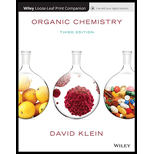
(a)
Interpretation:
For the given reactions, the product formed should be explained whether it is meso- compound or a pair of enantiomers.
Concept introduction:
- Electrocyclic reaction is a concerted cyclization reaction of conjugated polyenes (π-system), in which one π-bond is converted into an σ-bond and remaining π-bonds shift their positions. Thereby the newly formed σ-bond connects the two ends of π-system to form a ring.
- The mechanism of the ring formation in the Electrocyclic reaction is drawn by using arrows representing the forming σ-bond and the shifting of π-bonds in the π-system of a polyene.
- The reaction conditions (thermal or photochemical) controls the product in such a way that the rotation for end lobes (ring closure) of the HOMO of conjugated (π-system) polyene.
- According to Woodward-Hoffmann rule for thermal and photochemical Electrocyclic reactions,
| π-systems | Thermal | Photochemical |
| 4- π-electrons | Conrotatory | Disrotatory |
| 6- π-electrons | Disrotatory | Conrotatory |
- Meso-compound is superimposable to its mirror image.
- Enantiomers are the non-superimposable mirror images of each other.
To explain: the product formed is meso compound or a pair of enantiomers for each of the given reactions.
(b)
Interpretation:
For the given reactions, the product formed should be explained whether it is meso- compound or a pair of enantiomers.
Concept introduction:
- Electrocyclic reaction is a concerted cyclization reaction of conjugated polyenes (π-system), in which one π-bond is converted into an σ-bond and remaining π-bonds shift their positions. Thereby the newly formed σ-bond connects the two ends of π-system to form a ring.
- The mechanism of the ring formation in the Electrocyclic reaction is drawn by using arrows representing the forming σ-bond and the shifting of π-bonds in the π-system of a polyene.
- The reaction conditions (thermal or photochemical) controls the product in such a way that the rotation for end lobes (ring closure) of the HOMO of conjugated (π-system) polyene.
- According to Woodward-Hoffmann rule for thermal and photochemical Electrocyclic reactions,
| π-systems | Thermal | Photochemical |
| 4- π-electrons | Conrotatory | Disrotatory |
| 6- π-electrons | Disrotatory | Conrotatory |
- Meso-compound is superimposable to its mirror image.
- Enantiomers are the non-superimposable mirror images of each other.
To explain: the product formed is meso compound or a pair of enantiomers for each of the given reactions.
(c)
Interpretation:
For the given reactions, the product formed should be explained whether it is meso- compound or a pair of enantiomers.
Concept introduction:
- Electrocyclic reaction is a concerted cyclization reaction of conjugated polyenes (π-system), in which one π-bond is converted into an σ-bond and remaining π-bonds shift their positions. Thereby the newly formed σ-bond connects the two ends of π-system to form a ring.
- The mechanism of the ring formation in the Electrocyclic reaction is drawn by using arrows representing the forming σ-bond and the shifting of π-bonds in the π-system of a polyene.
- The reaction conditions (thermal or photochemical) controls the product in such a way that the rotation for end lobes (ring closure) of the HOMO of conjugated (π-system) polyene.
- According to Woodward-Hoffmann rule for thermal and photochemical Electrocyclic reactions,
| π-systems | Thermal | Photochemical |
| 4- π-electrons | Conrotatory | Disrotatory |
| 6- π-electrons | Disrotatory | Conrotatory |
- Meso-compound is superimposable to its mirror image.
- Enantiomers are the non-superimposable mirror images of each other.
To explain: the product formed is meso compound or a pair of enantiomers for each of the given reactions.
Want to see the full answer?
Check out a sample textbook solution
Chapter 16 Solutions
ORGANIC CHEMISTRY-PRINT COMPANION (LL)
- Calculate the pH and the pOH of each of the following solutions at 25 °C for which the substances ionize completely: (a) 0.000259 M HClO4arrow_forwardWhat is the pH of a 1.0 L buffer made with 0.300 mol of HF (Ka = 6.8 × 10⁻⁴) and 0.200 mol of NaF to which 0.160 mol of NaOH were added?arrow_forwardDetermine if the following salt is neutral, acidic or basic. If acidic or basic, write the appropriate equilibrium equation for the acid or base that exists when the salt is dissolved in aqueous solution. If neutral, simply write only NR. Be sure to include the proper phases for all species within the reaction. NaN₃arrow_forward
- A. Draw the structure of each of the following alcohols. Then draw and name the product you would expect to produce by the oxidation of each. a. 4-Methyl-2-heptanol b. 3,4-Dimethyl-1-pentanol c. 4-Ethyl-2-heptanol d. 5,7-Dichloro-3-heptanolarrow_forwardWhat is the pH of a 1.0 L buffer made with 0.300 mol of HF (Ka = 6.8 × 10⁻⁴) and 0.200 mol of NaF to which 0.160 mol of NaOH were added?arrow_forwardCan I please get help with this.arrow_forward
- Determine if the following salt is neutral, acidic or basic. If acidic or basic, write the appropriate equilibrium equation for the acid or base that exists when the salt is dissolved in aqueous solution. If neutral, simply write only NR. Be sure to include the proper phases for all species within the reaction. N₂H₅ClO₄arrow_forwardPlease help me with identifying these.arrow_forwardCan I please get help with this?arrow_forward
 ChemistryChemistryISBN:9781305957404Author:Steven S. Zumdahl, Susan A. Zumdahl, Donald J. DeCostePublisher:Cengage Learning
ChemistryChemistryISBN:9781305957404Author:Steven S. Zumdahl, Susan A. Zumdahl, Donald J. DeCostePublisher:Cengage Learning ChemistryChemistryISBN:9781259911156Author:Raymond Chang Dr., Jason Overby ProfessorPublisher:McGraw-Hill Education
ChemistryChemistryISBN:9781259911156Author:Raymond Chang Dr., Jason Overby ProfessorPublisher:McGraw-Hill Education Principles of Instrumental AnalysisChemistryISBN:9781305577213Author:Douglas A. Skoog, F. James Holler, Stanley R. CrouchPublisher:Cengage Learning
Principles of Instrumental AnalysisChemistryISBN:9781305577213Author:Douglas A. Skoog, F. James Holler, Stanley R. CrouchPublisher:Cengage Learning Organic ChemistryChemistryISBN:9780078021558Author:Janice Gorzynski Smith Dr.Publisher:McGraw-Hill Education
Organic ChemistryChemistryISBN:9780078021558Author:Janice Gorzynski Smith Dr.Publisher:McGraw-Hill Education Chemistry: Principles and ReactionsChemistryISBN:9781305079373Author:William L. Masterton, Cecile N. HurleyPublisher:Cengage Learning
Chemistry: Principles and ReactionsChemistryISBN:9781305079373Author:William L. Masterton, Cecile N. HurleyPublisher:Cengage Learning Elementary Principles of Chemical Processes, Bind...ChemistryISBN:9781118431221Author:Richard M. Felder, Ronald W. Rousseau, Lisa G. BullardPublisher:WILEY
Elementary Principles of Chemical Processes, Bind...ChemistryISBN:9781118431221Author:Richard M. Felder, Ronald W. Rousseau, Lisa G. BullardPublisher:WILEY





